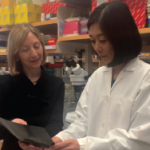Drs. Gravallese and Schett now reflect that it has been surprising what a change these initial discoveries have made in what is now the cross-disciplinary field of osteoimmunology. The term osteoimmunology has been attributed to Yongwon Choi, PhD, an immunologist who provided the RANKL knockout mouse used in Dr. Gravallese’s 2000 study. When Dr. Choi initially generated the RANKL knockout mouse, he had identified RANKL as a factor augmenting the interactions between dendritic cells and T cells. When the role of RANKL in osteoclastogenesis was also identified, Dr. Choi is reported to have said, “I was an immunologist, and now I’m an osteoimmunologist.’” The term stuck, and the cross-disciplinary field had a new name.

Dr. Schett, who heads the Department of Internal Medicine and Institute for Clinical Immunology, University of Erlangen-Nuremberg, Erlangen, Germany, has made, in concert with his colleagues, seminal contributions to the field of osteoimmunology. He points out that rheumatoid arthritis has become “a very good clinical example of the interaction between the immune system and the bone.”
Possible to Promote Repair?
Studying the mechanisms of the immune response has led to identification of immune system products that are either cell-surface bound or secrete molecules that can be targeted by monoclonal antibodies or receptor antagonists, with resulting success in blocking the inflammatory response that triggers osteoclastogenesis.7
Although the success of biologic agents to halt bone erosion has been huge, it’s now clear that there is a missing piece to the puzzle, says Dr. Gravallese.
“When we stopped the progression of bone loss in RA patients, I expected that we would see repair of the existing erosions. But that is not the case: After therapeutic intervention, the X-ray [of the bone erosions] typically looks the same, with only limited evidence of repair. We are very interested in the reasons that the bone does not fill in. We have demonstrated that inflammation affects osteoblasts as well as osteoclasts.”
We now know, says Dr. Aliprantis, that “immune system inflammation definitely drives bone loss by activating RANK ligand and osteoclasts and also probably decreases osteoblast function.”

Dr. Schett and his colleagues have conducted several longitudinal studies of patients treated with the current cytokine blockers, and have found some incomplete repair at erosion sites. However, he notes, “Cytokine inhibitors neutralize osteoclast differentiation, but they also blunt new bone formation.”
Julia Charles, MD, PhD, instructor in medicine, Rheumatology Division, Brigham and Women’s Hospital, Boston, and co-author with Dr. Aliprantis of a 2014 paper, “Osteoclasts: More than ‘bone eaters,’”8 adds that evidence from both genetic and in vitro biochemical studies shows that osteoclasts produce substances referred to as “clastokines” that may promote osteoblast recruitment or differentiation. Learning how to leverage these clastokines could result in the Holy Grail—to find an agent that promotes bone formation by osteoblasts and decreases bone resorption at the same time.
